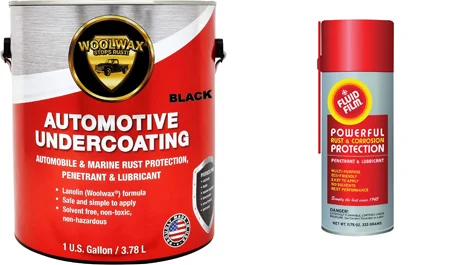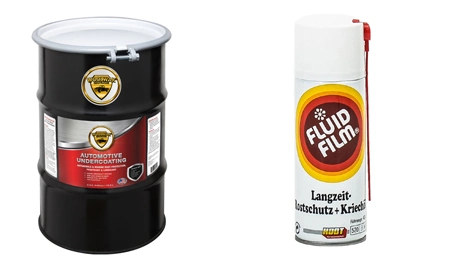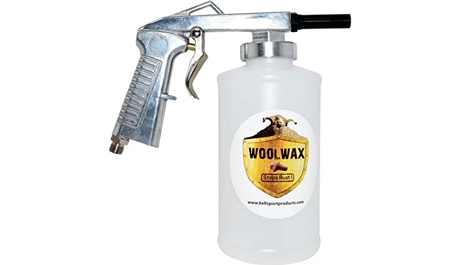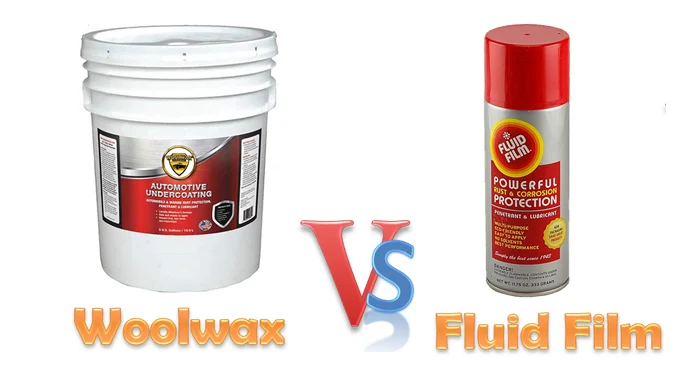Last Updated on February 28, 2023
When it comes to car maintenance, it is essential to understand how Woolwax differs from fluid film. Without the proper knowledge, it is easy to make a mistake that could cost you a lot of money. It is possible to damage a car’s paintwork by using too much Woolwax.
Then again, if you don’t apply enough fluid film, your car will be more susceptible to rust and corrosion. It is also possible to get the faulty product for the incorrect job when not knowing the difference between these two products.
We have put together all the information you need to know about Woolwax vs fluid film so that you can make an informed decision about which one is right for you or your car. Read on to find out everything there is to learn about them.
What is Woolwax, and What Does It Do for Your Car?
Woolwax is a substance used to protect car paint from the elements. It is made from a combination of lanolin and beeswax, forming a barrier that helps keep moisture and grime away from the paint. Woolwax can also help buff out scratches and provide a high gloss finish.
When appropriately applied, it can make your car’s paint look new. Many car care experts recommend using Woolwax regularly to keep your car’s paint looking its best. It is important to note that Woolwax should not be used on a car that has been recently waxed or detailed.
What is a Fluid Film, and is It Beneficial to Your Car?
A fluid film is a thin layer of oil that coats the metal surfaces of your car engine. This film provides several significant benefits, including reducing friction, protecting against wear, and preventing corrosion. Friction is the force that opposes the motion, and it can cause damage to engine components over time.
By reducing friction, a fluid film helps prolong your engine’s life. Wear is the process by which material is gradually removed from a surface through contact with another object. Fluids such as oil can help to protect against wear by providing a lubricating barrier between two surfaces.
Corrosion is the chemical reaction between a metal and its environment that causes the metal to degrade. Fluids can also help to prevent corrosion by forming a protective barrier on metal surfaces.
The Difference between Woolwax VS Fluid Film

In terms of protecting metal surfaces from corrosion, there are various products on the market. Two of the most popular options are Woolwax and Fluid Film.
Both products form protective layers over metal surfaces, albeit in different ways in a few key ways. Below are some of the most significant differences relating between these two products.
1. Function:
The main difference between Woolwax and the fluid film is their intended function. Woolwax is primarily used as a lubricant and protectant, while the fluid film is mainly used as a rust preventative.
This means that Woolwax will help keep your car’s moving parts moving smoothly, while the fluid film keeps corrosion and rust from forming on exposed metal surfaces.
2. Composition:
Woolwax is made from natural ingredients like lanolin, whereas fluid films are made from synthetic chemicals. Thus, Woolwax is more gentle on your car’s finish and won’t damage paint or other surfaces, whereas fluid film may be more effective at preventing rust but could also cause some damage if not used carefully.
3. Application:
The way you apply Woolwax, and the fluid film is also different. Woolwax is typically applied by hand, using a cloth or applicator pad, whereas fluid film is usually sprayed on with a pump sprayer.
This means that it’s generally easier to apply Woolwax evenly, but you may need to spend more time ensuring that all areas are covered with fluid film.
Car paint is protected with Woolwax, while exposed metal surfaces like the engine and engine cover are protected with fluid film.
4. Finish:
Woolwax will provide your car with a high-gloss finish, whereas fluid film will leave a more matte finish. In this regard, Woolwax is better suited for use on cars that are regularly driven and exposed to the elements, while the fluid film should only be used for vehicles stored indoors or in other protected environments.
5. Durability:
Woolwax and Fluid Film are both effective rust preventatives, with varying levels of durability. The woolwax is designed to be reapplied periodically, typically every few months.
As for the fluid film, it forms a more durable barrier that can last up to a year. Due to this, Fluid Film can be used in applications where extended protection is needed, such as on boat hulls or in industrial settings.
6. Difficulty:
Applying Woolwax requires more skill and knowledge than applying the fluid film. If done incorrectly, you can damage your car’s paintwork. Woolwax is a solid material that must be melted before it can be applied, but the fluid film is a liquid that is ready to use. This can make the fluid film easier to apply, especially in hard-to-reach places.
Conversely, Woolwax typically provides better coverage and protection than fluid film. Furthermore, Woolwax dries to a hard finish while the fluid film remains wet. This can make Woolwax more challenging to remove if it gets on areas you don’t want to be protected.
7. Reapplication:
Woolwax needs to be reapplied more often than fluid film. Woolwax works by forming a durable, water-repellent barrier on the surface of the fabric.
Although, this barrier will eventually break down, especially if the fabric is exposed to sunlight or heat. As a consequence, woolwax must be applied regularly to maintain its efficacy.
The fluid film, on the other hand, penetrates the fabric and bonds with the fibers at a molecular level. This gives it much better durability, and it will usually only need to be reapplied once or twice a year.
Aside from that, the fluid film does not degrade in sunlight or heat, making it ideal for use in harsh conditions. Thus, the fluid film offers superior protection against mud, stains, and water damage.
8. Cost:
Both products are designed to protect metal surfaces from rust and corrosion, but they differ in cost. Woolwax is generally more expensive than fluid film but has a longer lifespan. This is because Woolwax forms a thicker barrier that is more resistant to wear and tear.
Furthermore, Woolwax is less likely to drip or run off, ideally suited to high-traffic areas. Therefore, Woolwax is often the preferred choice for industrial applications. Even so, the fluid film can be a more cost-effective option for smaller projects or surfaces that do not require as much protection.
Woolwax Vs Fluid Film : Which One Is Better for Your Needs?

The debate between wax films and fluid films has been long-standing. Each has its advantages and disadvantages, making it essential to choose the right product for your needs.
Woolwax is a natural product that is made from lanolin, which is derived from sheep’s wool. It is environmentally friendly and non-toxic, making it a safe choice for children and pets.
Aside from this, Woolwax is water-resistant and effectively protects corroded metals. Despite this, some people find it challenging to apply evenly and can be messy to work with.
As opposed to the fluid film, a synthetic material composed of polymers, it dries quickly and does not require any special application equipment. Also, the fluid film provides excellent protection against rust and corrosion.
When choosing between Woolwax and fluid film, you should consider your specific needs. Whenever it comes to an environmentally friendly option, then Woolwax may be the better choice. Regardless, if you want something that dries quickly and resists rust and corrosion, then the fluid film would be the best option.
FAQs
How long does Woolwax Last?

Woolwax can last for quite a long time if it is adequately taken care of. The lifespan of a can of Woolwax can vary depending on how often it is used, but if it is used sparingly, it can easily last for several years.
Conversely, if Woolwax is left out in the weather or used excessively, it will break down much faster and need to be replaced more frequently. In general, though, Woolwax is a durable product that can provide many years of service with proper maintenance.
Woolwax is Washable, right?
Although Woolwax is washable, it is not advised to do so. When Woolwax gets wet, it can lose its shape and become matted. On top of that, the water can cause the wax to shrink, making it difficult to put back on. If you must wash your Woolwax, be sure to use cold water and a gentle detergent.
Gently squeeze the water out of the wax, being careful not to wring it out. Once the wax is dry, you can reshape it back into its original form. Although, it is generally best to avoid washing Woolwax altogether.
Does FLUID FILM Creep?
The answer is yes, FLUID FILM can and will creep. This is because it is an oil-based product designed to lubricate and protect metal surfaces. When applied to a surface, it will slowly seep into cracks and crevices, eventually hardening and providing protection. This barrier will help prevent rust and corrosion and make it easier for moving parts to slide against each other.
When should you use Fluid Film Instead of Woolwax?
In general, the fluid film is best used on surfaces exposed to salt water or high humidity, as it protects better against corrosion. Conversely, Woolwax is a better choice for surfaces exposed to direct sunlight or extreme temperatures, as it helps to prevent drying and cracking. If wool wax undercoating is not an option, fluid films could also be used as stand-alone rust preventative.
How Can You Make Sure you’re Using Them Correctly?
You can do a few things to operate your lawn mower correctly. First, be sure to read the manual that came with your mower. This will give you specific instructions on how to set up and operate your particular model.
Second, take the time to inspect your mower before each use. Ensure all the blades are clean and sharp and that no junk is caught in the engine.
Finally, be sure to mow in a straight line to avoid damaging your lawn. By following these simple tips, you can be sure you’re moving correctly and keeping your lawn looking its best.
Final Thoughts
After researching the Woolwax vs Fluid Film, we have concluded that they are both great at protecting metal surfaces. They both have pros and cons, but overall we believe either would do a great job protecting your investment.
If you are looking for a product to protect your car, boat, or other outdoor equipment, we recommend giving both of these products a try. They are both affordable and effective, so you can’t go wrong.
Woolwax is an excellent option if you want a product that is easy to apply and doesn’t require any special tools or equipment. Fluid Film is a great choice for protection that will last longer and provide more durable protection. Whichever product you choose, we are confident that you will be happy with the results. Thanks for reading.
